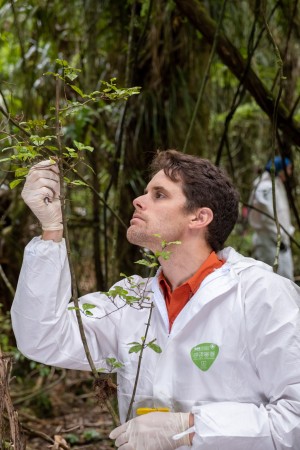Myrtle rust leaving its mark on forest ramarama

James McCarthy assessing disease on ramarama
A group of Manaaki Whenua researchers headed into Mount Egmont National Park at the base of Mt Taranaki recently to assess the extent of myrtle rust spread in the forest.
Senior researchers Maj Padamsee and James McCarthy together with field techs Rowan Buxton, Chantal Probst, James Arbuckle, and Jo Peace, and Beyond Myrtle Rust Project Manager Renee Johansen spent four days in the forest painstakingly recording every leaf on 146 tagged ramarama (Lophomyrtus bullata) trees. They also checked neighbouring plants for signs of wider infection around these individuals.
It’s the third and final disease assessment of these trees as part of the MBIE Endeavour-funded Beyond Myrtle Rust project, and there were some glum faces during the count. “We counted 37,000 leaves across these 146 plants in 2021, and in 2022 this had dropped to 29,000. We’re not yet sure how many the plants have died this year, but we finished the survey a day earlier than expected which isn’t a good sign,” says James.
Ramarama is known to be particularly susceptible to myrtle rust, and on several trees there were clear signs of infection – tiny yellow pustules (structures containing spores) were present on new leaves. Plants that have sustained prolonged infection often present with dead stems.
Myrtle rust, which is caused by the fungus Austropuccinia psidii, blew in from Australia in 2017 and has already infected many of New Zealand’s native myrtle plants, including pōhutukawa, mānuka, ramarama, rōhutu, rātā and swamp maire. Heavy infections can be deadly.
The survey for myrtle rust across large transects containing ramarama in the Mt Taranaki forests is looking at whether various environmental factors impact infection levels.
Researchers are also looking to answer questions around how Myrtaceae species contribute to the functioning of New Zealand forests, so they can understand what the impact will be if we start to lose them.
“Do populations close to the edges, where the forest may be less intact, have greater infection than those in the forest interior?” says James. “Do we see lots of myrtle rust on ramarama because we tend to travel along tracks where the forest is degraded, and where the disease might have more opportunities to infect? Might populations in more pristine forests be infected less?”
“In addition, the role some Myrtaceae species, such as ramarama, play within a forest ecosystem is largely unknown.”
If you think you’ve seen myrtle rust, please report your discovery on iNaturalist.
For more information about myrtle rust, please see our FAQ or https://www.myrtlerust.org.nz/


![[Austropuccinia psidii] on ramarama Image](/assets/Discover-Our-Research/Biosecurity/Beyond-Myrtle-rust/Austropuccinia-psidii-on-ramarama__FitMaxWzE1LDE1XQ.jpg)
